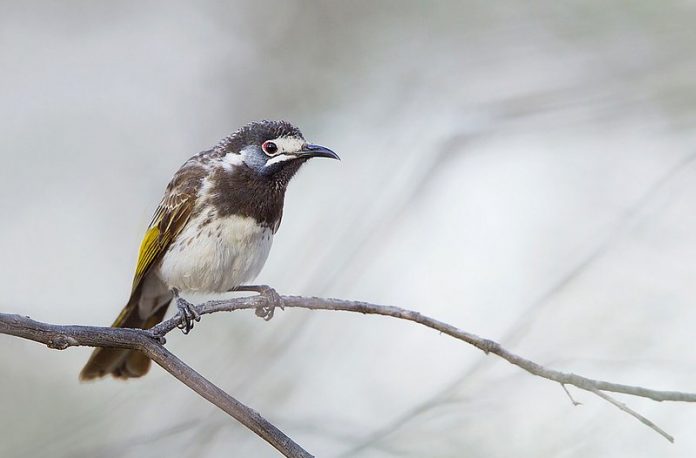Living in Australia’s arid zone, with its erratic rainfall, White-fronted Honeyeaters (Phylidonyris albifrons) are nomads. White-fronted Honeyeaters arrive in large numbers where nectar-rich shrubs are coming into flower, nest, and then leave as blossoming falls Like other species of Phylidonyris honeyeaters.
They are primarily nectar-feeders, exploiting flowering eucalypts, mistletoes, grevilleas, and hakeas as well as extremophiles. The size of the White-fronted Honeyeater is about 160-180 mm in length. Both sexes are similar, but males are larger. The crown is dusky, and flecked faintly white; hind-neck to shoulders and rump gray-brown streaked black; wings and tail gray-brown edged dull yellow.

The forehead and lores ring around the eye white, with small red wattle behind the eye; ear-coverts grey with a white hind plume; white malar line. Throat and upper breast black with fine white center streaks; rest of underparts white-streaked black on upper breast, flanks, and undertail. The eyes are dark brown and the bill is black, along with a slate fleet.
They are immature as adults but plainer brown on head and back; wings and tail edged browner; throat whitish brown, mottled over the breast. White-fronted Honeyeater call consists of a single metallic, canary-like kweet or kwaak as a marker; scolding harsh dik-dik-dik in alarm. The song of White-fronted Honeyeater is metallic pert-pertoo-weeet or quaak-peter-peter, the first note harsh, the rest loud and melodic; given as advertisement.
Honeydew and insects are also taken, the insects mostly in midair in short flying sallies. Flight, from thicket to thicket, is of long, swift undulations. White-fronted Honeyeaters nest in pairs in loose colonies, the males making song flights to advertise feeding and breeding territory; they defend their territories vigorously. The nesting and breeding season is in August-December, and after rains.
The bird builds a nest in a cup of grass or bark strips interwoven with cobwebs; lined with wool or vegetable matter; usually suspended in a fork of bush or small tree, within 2.5 m of the ground. Normally, there are 2-3 eggs; pale buff spotted at the larger end with red-brown and underlying purple; oval, about 20 x 14 mm. However, the incubation period is about 14-15 days. The young bird fledges in about 15 days. The distribution of White-fronted Honeyeater is in dry inland scrubs and ma/lee and dry coastal parts of the south and west. No races.
